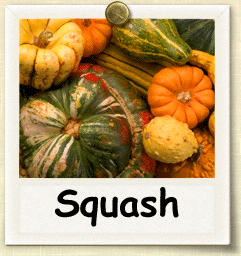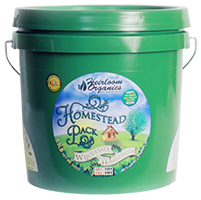|
Home > Guides > Vegetables > Squash |
|
How to Grow Squash | Guide to Growing Squash |
|
|
|
|
| |
 |
|
Overview |
|
|
|
|
|
| |
|
| |
Summer squash comes in a variety of shapes and colors. Bush varieties take up relatively little space, and if kept picked will keep producing right up to frost.
Winter squash are easy to grow -- if you have room. In addition to the familiar butternut and acorn squash, varieties come in a staggering diversity of fruit size, shape and color. Choose bush varieties if space is tight.
|
|
| |
|
|
| |
|
|
| |
|
|
5 to 10 days, 60F to 105F |
|
|
|
|
|
|
|
|
Well Drained, High Fertility |
|
|
|
|
|
|
|
|
|
|
|
|
Growing Guide
GROWING NOTES
Prefers well-drained, fertile, loose soil, high in organic matter with pH between 5.8 and 6.8. Plentiful and consistent moisture is needed from the time plants emerge until fruits begin to fill out.
Most varieties grow on vines that spread 6 feet or more. If space is tight, choose smaller bush or semi-bush varieties.
Most summer squash grow on compact vines, in contrast to the sprawling vines of most winter squash and pumpkins.
Some varieties have interesting "water marks" on their foliage.
Most summer squash varieties form a compact, bushy vine.
MAINTAINING
Squash like warm soil and are very sensitive to frost. So don’t be in a rush to plant early in spring. Wait until danger of frost has passed and soil has warmed to about 70 F, or about 2 weeks after the last frost date.
Winter Squash
Unless you are trying to grow a long-season variety in an area that gets early frosts, there’s really no need to start winter squash inside. Instead, direct seed ½ to 1 inch deep into hills (which warm and drain earlier in the season) or rows. Sow 4 to 5 seeds per hill. Space hills about 4 to 8 feet apart, depending on the size of the fruit. (The larger the expected size of the squash, the larger the vine and the farther apart you should space the hills.) When the plants are 2 to 3 inches tall, thin to 2 to 3 plants per hill by snipping off unwanted plants without disturbing the roots of the remaining ones. In rows, sow seeds 6 to 12 inches apart in rows 4 to 8 feet apart. Snip off plants to thin to one plant every 18 to 36 inches.
If you need to start plants early, plant inside in 2- to 3-inch pots or cells 3 to 4 weeks before transplanting outside. Sow 3 or 4 seeds per pot and thin to one or two plants by snipping off the weaker plants to avoid damaging the roots of those that remain. Harden off by cutting back on water and reducing temperature before transplanting. Plant transplants out in the garden at the same final spacings above after all danger of frost has passed.
If you need to start plants early, plant inside in 2- to 3-inch pots or cells 3 to 4 weeks before transplanting outside. Sow 3 or 4 seeds per pot and thin to one or two plants by snipping off the weaker plants to avoid damaging the roots of those that remain. Harden off by cutting back on water and reducing temperature before transplanting. Plant transplants out in the garden at the same final spacings above after all danger of frost has passed.
Mulching plants helps retain moisture and suppress weeds. Mounding soil around the base of the plants can discourage squash borers from laying eggs.
Summer Squash
Direct seed ½ to 1 inch deep into hills (which warm and drain earlier in the season) or rows. Sow 4 to 5 seeds per hill. Space hills 3 to 4 feet apart. When the plants are 2 to 3 inches tall, thin to 2 to 3 plants per hill by snipping off unwanted plants without disturbing the roots of the remaining ones. In rows, sow seeds 4 inches apart in rows 4 to 5 feet apart. Snip off plants to thin to one plant every 12 to 24 inches.
For extra early crops, start inside in 2- to 3-inch pots or cells 3 to 4 weeks before transplanting outside. Sow 3 or 4 seeds per pot and thin to one or two plants by snipping off the weaker plants to avoid damaging the roots of those that remain. Harden off by cutting back on water and reducing temperature before transplanting. Plant transplants out in the garden about 1 to 2 feet apart after all danger of frost has passed.
To hasten first harvest by as much as 2 weeks, use black plastic mulch to warm soil before direct seeding or transplanting. Early fruits are sometimes wrinkled, turn black or rot due to poor pollination.
At the end of the season, remove or till in vines to reduce mildew. Use row covers to protect plants early in the season and to prevent insect problems. Remove cover before flowering to allow pollination by insects or when hot weather arrives.
Mulching plants helps retain moisture and suppress weeds. Mounding soil around the base of the plants can discourage squash borers from laying eggs.
|
|
| |
|
| |
Heirloom seeds are the gardeners choice for seed-saving from year-to-year. Learning to save seeds is easy and fun with these books. Before you harvest, consider which varieties you might want to save seeds from so that your harvesting practice includes plants chosen for seed saving. Be sure to check out our newest seed packs, available now from Heirloom Organics. The Super Food Garden is the most nutrient dense garden you can build and everything you need is right here in one pack. The Genesis Garden s a very popular Bible Garden collection. The Three Sisters Garden was the first example of companion planting in Native American culture. See all of our brand-new seed pack offerings in our store.
|
|
| |
|
|
| |
Harvesting Guide
HARVESTING
Summer - 60-70 days. These squash are picked immature before they are fully formed. The skin should be soft and tender, otherwise the squash will be overripe and of poor quality.
Check squash plants almost daily when they start to flower, as the fruit will develop in 2 or 3 days in hot growing weather. The vines must be kept picked or the plants will stop producing.
Winter - 90-120 days. When the stems turn a light green yellow color, the squash should be fully ripe. The rind will be thick and tough. Cut, do not pull, the ripe fruit from the plant. Two to three inches of stem must remain for proper storing. This may increase the sugar content.
SAVING SEEDS
Insect pollinated. Take caution unless you are hand pollinating, as many summer squash varieties are the same species as many pumpkins and winter squashes. Different varieties of the same species need to be isolated by 1/4 mile to prevent cross-pollination. Barriers such as tree lines, woods or buildings existing between the fields can reduce this distance. Treat summer squash the same as usually done for winter storage of squashes and pumpkins, allowing summer squash varieties to grow to a large size with a hard outside skin. After all squashes have reached this stage, harvest and let them sit for a period of after-ripening for 3-6 weeks or up to several months. Remove the seeds, rinse in water and dry. Use of a 1/2" and 1/4" screen can help with cleaning. Squash seeds remain viable for 6 years under cool and dry storage conditions.
|
|
| |
|
|
|
| |
|
|
|
|
|
| You can find this variety in the following Seed Packs: |
|
  
  |
|
| Click the packs below to see some of our other wonderful products |
|
|
|
|
|
|
|